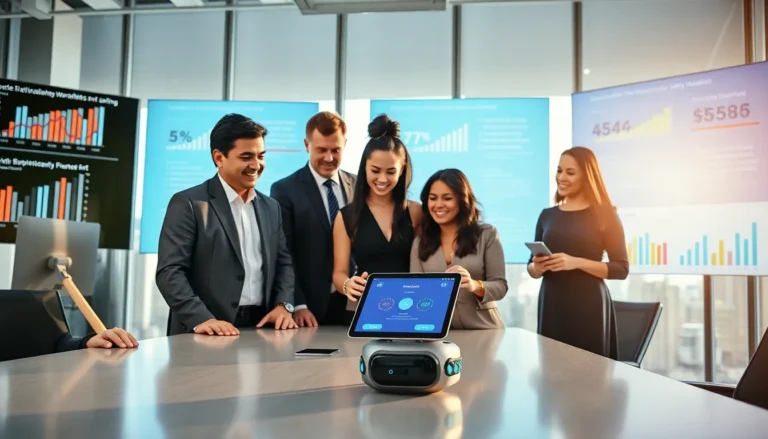Table of Contents
ToggleEver glanced at your iPhone lock screen and thought, “Why’s the time sitting there like it owns the place?” If you’re tired of that stubborn clock hogging the spotlight, you’re not alone. Many users want to customize their lock screens, giving them a personal touch that reflects their style. After all, it’s your phone, so why shouldn’t your timepiece play by your rules?
Understanding Your iPhone Lock Screen
The iPhone lock screen serves as the first point of interaction for users. It displays essential information and offers quick access to key features.
Key Features of the Lock Screen
Users find several vital components on the lock screen, including the time display, notifications, and shortcuts to apps. The clock typically appears at the top center, ensuring visibility. Notifications from messaging and social media apps surface from the top, enabling user awareness. Quick access features include the camera and flashlight, located at the bottom right and left corners, respectively. All these elements combine to create a functional interface for immediate engagement.
Importance of Customization
Customization enhances user experience significantly. Personalizing the lock screen allows individuals to express their unique style. By changing wallpapers, adjusting clock styles, or rearranging widgets, users make the device feel more personal. Many appreciate the option to select specific notifications that matter most, which aids in reducing distractions. Customization ultimately boosts satisfaction, leading to a more enjoyable daily interaction with the device.
Steps to Move the Time on iPhone Lock Screen
Adjusting the time display on an iPhone lock screen enhances personalization. Users can follow a few straightforward steps to customize their experience.
Using Accessibility Settings
To customize the lock screen time, access the Settings app. Navigate to the Accessibility section. Enable the “VoiceOver” feature to hear the time read aloud. Those needing visual clarity might find this helpful. Explore the “Display & Text Size” options. Here, users can alter text size, making the time more visually pleasing and less obtrusive.
Adjusting Display Settings
Display settings play a crucial role in customizing the lock screen. Open the Settings app, then tap Wallpaper. Choose a wallpaper that complements personal style. Selecting a lighter background may allow the time to stand out. Explore the “Brightness and Wallpaper” settings to adjust brightness levels. An optimal level enhances visibility while lowering distractions.
Alternative Customization Options
Users can explore various ways to personalize their lock screens beyond simply adjusting the time display. Customizing elements like wallpaper and widgets significantly enhances the lock screen experience.
Changing Wallpaper
Choosing a wallpaper creates a distinct look for the lock screen. Users should consider selecting images that resonate with their preferences. Dynamic wallpapers provide an animated effect, while still images maintain a classic appeal. To access wallpaper settings, navigate to Settings, then Wallpaper. From there, options for choosing or taking a photo offer flexibility in personalization. Opting for high-resolution images improves the overall aesthetic, ensuring clarity. This thoughtful approach to wallpaper selection enhances the visual impact of the time display.
Using Widgets
Incorporating widgets into the lock screen can elevate functionality. Various widget types, including weather, calendar, and reminders, keep vital information at users’ fingertips. Adding widgets involves a straightforward process. Users must long-press on the lock screen, select the ‘+’ icon, and choose from available widget options. Customization extends to size and placement, allowing unique arrangements that suit individual needs. Through carefully selected widgets, users can access daily information quickly, minimizing time spent navigating apps. This feature improves user experience while adding to the lock screen’s customization.
Best Practices for Lock Screen Customization
Customizing the iPhone lock screen enhances usability and personal expression. Observing a few best practices ensures a satisfying user experience.
Ensuring Readability
Readability remains crucial for effective lock screen use. Choose a background wallpaper that contrasts well with the text. Opt for large, clear fonts that deliver information at a glance. Adjust brightness settings to maintain visibility, particularly in diverse lighting conditions. Users may also consider simplifying screen elements to reduce distractions. Small adjustments, like increasing text size, can significantly improve clarity. Regularly testing different layouts can help find the most legible setup for personal preferences.
Maintaining Privacy
Privacy plays an essential role in lock screen design. Limit sensitive information displayed on the lock screen to prevent unauthorized access. Disabling notifications for specific apps ensures personal data stays secure from prying eyes. Users may also consider utilizing the “Hide Notifications” feature to keep alerts private. Customizing widgets to show less personal content can further enhance security. Selecting a strong passcode serves as an effective additional layer of protection. Employing these strategies allows individuals to enjoy personalization without compromising their privacy.
Customizing the iPhone lock screen offers users an opportunity to enhance both functionality and personal expression. By adjusting the time display and incorporating personalized elements like wallpapers and widgets, users can create a lock screen that truly reflects their style.
Implementing best practices ensures readability and minimizes distractions while maintaining privacy and security. With these simple steps, anyone can transform their lock screen into a unique and efficient interface. Embracing this customization not only improves the user experience but also fosters a deeper connection with the device.




